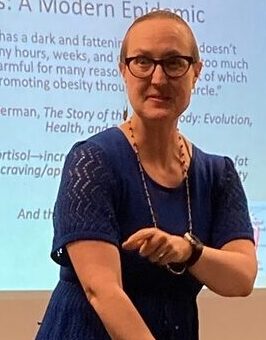
I was grateful for the opportunity to speak at Brooklyn Co-Op Preschool in SE Portland, Oregon on November 19th of 2024. As the featured speaker for their parent/teacher meeting, it was my job to speak for about an hour on a topic featuring neurodivergence. For those who may not be exposed to education buzzwords, neurodivergence means difference in how people think. ADHD is an example of neurodivergence. Individuals who are on the autism spectrum are also neurodivergent.
Portland, Oregon Speaking Engagement on Brain Science and Mindfulness
I spoke on how the brain works, how stress is processed in the brain and body, and how yoga and mindfulness help address stress. Using Dr. Paul MacLean’s triune brain model and Dr. Daniel Siegel’s fist model, I explained how stress hijacks our brains’ most advanced, logical functions. To be more specific, when our limbic brains detect danger, they fire the stress alarms and signal that the prefrontal cortex, the center of learning and planning, should go offline.
A big takeaway for parents and teachers is that people cannot be logical or reflective until they feel calm and safe. Under stress, we cannot answer the question, “Why did you do that?!” First, we must help deactivate the stress response. Once the prefrontal cortex comes back online, and the individual feels more relaxed, they can start to think about why they responded that way, and what choices could be better in the future.
“My hearing is like having a sound amplifier set on maximum loudness. My ears are like a microphone that picks up and amplifies sound. I have two choices: 1) turn my ears on and get deluged with sound or 2) shut my ears off… I discovered that I could shut out painful sounds by engaging in rhythmic stereotypical autistic behavior.”
(Grandin, 2000)
Because this group was interested in neurodivergence, I added information on how the brains of neurodivergent individuals experience stress differently. For instance, I included a quote from Temple Grandin on how her brain works, and how she can use stemming to stay calm:

“My hearing is like having a sound amplifier set on maximum loudness. My ears are like a microphone that picks up and amplifies sound. I have two choices: 1) turn my ears on and get deluged with sound or 2) shut my ears off… I discovered that I could shut out painful sounds by engaging in rhythmic stereotypical autistic behavior.” .
Looking at pictures from that night, I am reminded how much I enjoy speaking to groups of all sizes on brain science, mindfulness, and yoga. We are blessed to be living in an age when science is verifying what yogis have said for millenia, and when parents have tools to break cycles of emotional stress. If your group is looking for an interesting, dynamic speaker, please get in touch. I would love to provide an evening of reflection through active learning.
Sources
Grandin, T. (2000, June). Visual thinking, sensory problems & communication difficulties. Synapse: Reconnecting lives. https://www.autism-help.org/story-sensory-communication.htm

